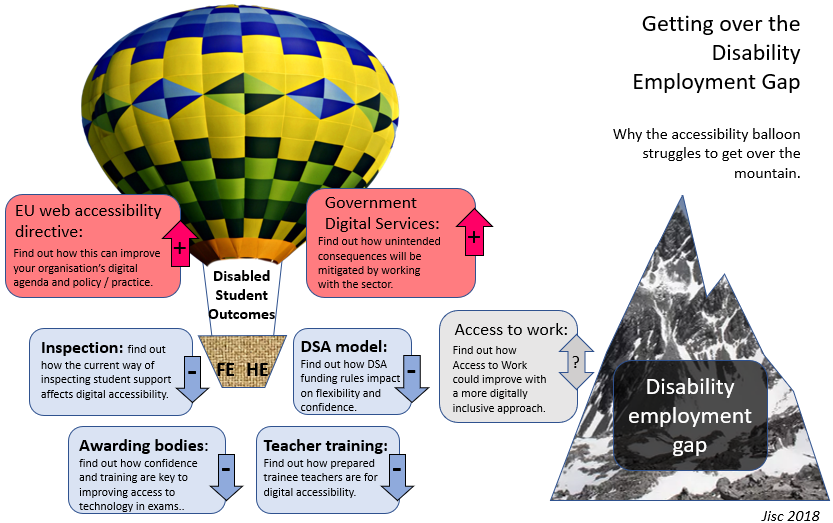New regulations applied to public sector bodies on 23 September 2018. You must make your website or mobile app accessible by making it ‘perceivable, operable, understandable and robust’. Accessibility standards will help you do this.
You must also:
- publish an accessibility statement – this must have details of content that doesn’t meet accessibility standards
- if someone requests it, provide an accessible alternative within a reasonable time for content that doesn’t meet the standards.
A Good Thing?
There is no doubt that this legislation is a Good Thing. It will help disabled students, and in the process, improve the digital experience of all students. It needs joined-up thinking and coherent policies within institutions. This should result in improved quality assurance for digital content. It should create more effective digital experiences.
However, disability regulations are only one of many influences on an educational provider. For educators to provide inclusive experiences for disabled students, some of the other agencies that influence the student experience need to develop better awareness of digital inclusion.
Cars and red flags
From 1865 to 1896 the Locomotive Act required “self-propelled vehicles to be led by a pedestrian waving a red flag or carrying a lantern to warn bystanders of the vehicle’s approach”. Speed benefits that a self-propelled vehicle might enjoy (12 mph in those heady days) were limited by the requirement for a pedestrian walking at 3 mph. The benefits of motorised transport didn’t depend on better engines as much as it depended on changing the societal constraints.
The new legislation could suffer a similar fate.
Organisations and individuals should benefit from an inclusive approach based on a social model of disability. But this is undermined if digital accessibility is not embraced in the culture of inspection regimes, awarding bodies, disabled student allowances, teacher training and support in accessing work. Are these the pedestrians with red flags who limit the speed of change?
Over the next few months, we are blogging on these different issues in the context of the “big picture” of digital accessibility. The focus is on the ultimate aim of making disabled students more independent and more employable.
The Disability Employment Gap is a shameful waste of talent. Thousands of skilled and motivated disabled people are underqualified, under-employed or unemployed. The real disability is often in the institution. Educators don’t know how to create accessible content that allows students to work more effectively. Or disabled students have limited guidance on technology that can make them independent.
Nobody pretends technology is a silver bullet that will solve the problem overnight. But we recognise that current models of disability support, staff training, school and college inspection etc depend on outdated models of disability.
Balloons and mountains
In a digital world, the disability employment gap should be shrinking rapidly. Disabled student outcomes should be rising higher and faster. The fact that they aren’t, suggests that other factors are at work. If disabled student outcomes are a balloon, rising on the buoyancy of digital accessibility, what is the ballast holding it back from clearing the mountain?
The ‘big picture’ of digital accessibility.
The image above explores disabled student outcomes with the metaphor of a balloon (disabled student outcomes) attempting to cross a mountain range – the disability employment gap.
Positive forces lift the balloon. These include the Public Sector web accessibility legislation and Government Digital Services advice for the sector. These lift the balloon because they focus on removing barriers at source.
However negative forces pull down. These include
- current Inspection regimes where digital accessibility is entirely absent,
- awarding bodies: digital accessibility of exams isn’t yet mandated. It isn’t predictable either.
- the Disabled Student Allowance can be great but training on inbuilt and mainstream assistive technology cannot be funded.
- teacher training, technology-enhanced learning can be patchy and rarely includes digital accessibility.
Access to work is an obvious aid to ‘crossing the employment gap’ mountain range. However, it focuses on specific tools for ‘fixing’ the problem. This leaves users unaware of other mainstream solutions. It can also leave their employers unaware of accessibility barriers they might be creating accidentaly.
Each of these themes will be explored in later posts. Guest editors will help us look at the details. A summary piece explores how you can use the legislation to improve your organisation’s digital agenda and policy / practice.
Please contribute via comments. The Digital Accessibility Regulations Jiscmail list is another good place to join the debates.
So please add your voice to the debates and help us reflect the needs of the post 16 education sector as effectively as we can.

